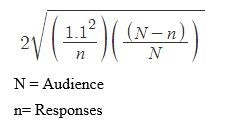Reports
Report Statistics
Interpolated Median
The Interpolated median adjusts the median upward or downward by weighting the score positively or negatively based on the distribution of student responses.
Example
Using the following scale, which is the current scale used for all SLEQs.
Strongly Disagree = 1
Moderately Disagree = 2
Neutral = 3
Agree = 4
Strongly Agree = 5
If you received the following scores for one of your questions:
2 X Strongly Disagree
9 X Agree
10 X Strongly Agree
The median would be 4
The mean would be 4.19
And the interpolated median would be 4.44
The interpolated median shows that there were more responses above 4 than bellow it.Ģż If the interpolated median would have been 3.6, that would be an indication that there were more responses bellow 4 than above it.
The following table shows what your median would be based on your interpolated median.Ģż
| If your Interpolated Media is between |
Median |
|---|---|
| 1 and 1.5 | 1 |
| 1.5 and 2.5 | 2 |
| 2.5 and 3.5 | 3 |
| 3.5 and 4.5 | 4 |
| 4.5 and 5 | 5 |
Reliability Assessment
The reliability assessment score measures how confident we are that the responses accurately represent all students registered in the course.

"The formula for the Reliability Assessment is based on a formula fromĢż"ElementaryĢżSurveyĢżSampling" (by Richard L.ĢżScheafferĢżet. al.). the constant 1.1 is the variance of the 5 rating scale question which are the most common in course evaluations and surveys.
The Input and Output
The formula takes the invited (Audience N) and responded (Responses n) counts as the inputs, it will outputĢża value between 0 and 2.2. The closer the number to 0 the more reliable the data. "
Source: Shadi Khader - June 22, 2015, https://support.explorance.com

Examples
As your class size goes up, the number of respondents needed for us to have confidence in the representativeness of the data decreases.





Report Sections
Section A contains a set of common questions that are asked across all courses for which SLEQ data are collected. The questions, presented as a series of statements to which the students are asked the degree to which they agree or disagree using a 5-point Likert scale (1 ā strongly disagree, 2 ā disagree, 3 ā neutral, 4 ā agree, and 5 ā strongly agree) with a Not Applicable option, are listed below. They probe the studentās perceptions of the effectiveness of the Instructorās teaching.
STIMULATION OF LEARNING: The Instructor conducted the class/clinical in such a way that I was stimulated to learn.
ORGANIZATION: The instructor organized the class/ clinical well. COMMUNICATION: The instructor communicated clearly during the class/clinical.
COMMUNICATION: The instructor communicated clearly during the class.
ENTHUSIASM: The instructor showed enthusiasm for the subject matter of the class/clinical.
FAIRNESS: The instructor used fair evaluation methods to determine grades.
FEEDBACK: The instructor provided constructive feedback (considering the class/clinical size).
CONCERN FOR LEARNING: The instructor showed genuine concern for my learning.
In addition, each Instructor shall receive a composite mean of their scores across the 7 dimensions of teaching explored in Section A.
Section B contains up to six optional customized course level questions chosen by the offering academic unit for purposes of program or course improvement, with the results being provided to both the Instructor and the academic unit head;
Section C contains up to six optional customized questions chosen by the instructor for purposes of receiving formative feedback for their course, with results provided only to the Instructor; and,
Section D collects qualitative textual data in the form of student comments. This section provides students the opportunity to respond to two open-ended questions.
The following questions will be asked for each course:
A. What are one or more specific things about the course design or instruction that especially helped to support your learning?
B. What are one or more specific things about the course design or instruction that could be improved to better support your learning?
All students will be instructed that these comments will be submitted for promotion and tenure purposes, and other human resources decisions, and provided a link to the Guidelines to Providing Constructive Feedback available at: [link to the guidelines here]
Section E contains a set of a set of common questions that are asked across all courses for which SLEQ data are collected. The questions are presented as a series of statements about course content to which the students are asked the degree to which they agree or disagree using a 5-point Likert scale (1 ā strongly disagree, 2 ā disagree, 3 ā neutral, 4 ā agree, and 5 ā strongly agree) with a Not Applicable option and an I Donāt Know option, are listed below.
1. Course materials reflected a variety of diverse perspectives on the course topic(s).
2. The instructor did not include materials that contained offensive or discriminatory ideas except to educate students about discrimination, oppression or educate about other existing perspectives.Ģż
3. Course materials were universally accessible.
All students will be instructed that these comments will not to be used for tenure and promotion. ĢżDeans, Department Heads, and Chairs of Faculty Equity, Diversity, and Inclusivity (EDI) committees will receive anonymized aggregate data for their academic unit.
These course content questions were created by the Dalhousie Student Union.Ģż The purpose of these questions is toĢżgive students an opportunity toĢżidentify racist, sexist, homophobic, and any otherĢżoppressiveĢżcontent in courseĢżcurricula and literatureĢżand share that feedback anonymously with their professors. These questions will also support course instructors in developing innovative curricula to support diversity, developing cross-cultural competencies, and fostering safer spaces by identifying areas of strengths and weaknesses in existing course content.Ģż Making course content changes will be solely at the discretion of the course instructor.
In addition, the following questions will be asked about course content:
A. What are one or more specific things about the course content that helped create an inclusive learning environment?
B. What are one or more specific things about the course content that could be improved to create a more inclusive learning environment?
All students will be instructed that these comments will not to be used for tenure and promotion. Open-ended questions will not be shared with anyone other than the course instructor. The intention is that recipients of the data can use it to inform faculty and departmental EDI initiatives, education, and conversations.
